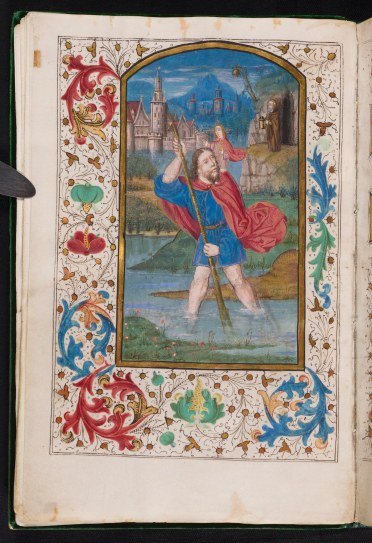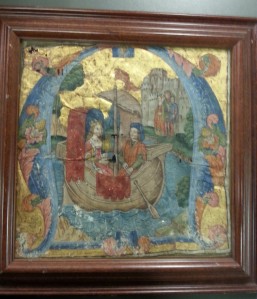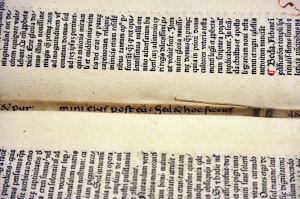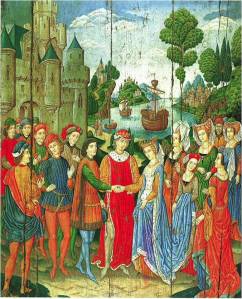
The Flight into Egypt, Walters Art Museum, MS W.188, f.112r
This is a story about how science and forensics can help translate a question of subjective connoisseurship into one of objective certainty. In other words, you can’t argue with science.
Back in 2001, I was hired by the Department of Special Collections at Wellesley College (in Wellesley, Mass.) to catalogue their very fine collection of pre-1600 manuscripts. I spent several years working my way through the collection, researching contents, origin, provenance, and physical characteristics of the codices, cuttings, and single leaves, eventually producing a 91-page document that became the source for the library’s MARC records. Some of manuscripts have been digitized and are online here. Five were included in the Beyond Words exhibition in 2016; those records are here.

Wellesley College, MS 29, f. 14v (St. Christopher)
Today, I want to focus on one manuscript in particular, Wellesley MS 29. MS 29 is a late-fifteenth/early-sixteenth-century Book of Hours for the Use of Utrecht, written and decorated in the Northern Netherlands. The full-page miniatures in the manuscript have recently been attributed by James Marrow to the “Masters of the Dark Eyes” (see Hamburger, et al., Beyond Words: Illuminated Manuscripts in Boston Collections (Chestnut Hill: McMullen Museum of Art, 2016), Cat. 128 (p. 163) – you can download Marrow’s entry and description of the manuscript from the Beyond Words website). Artistic attribution is a tricky and often somewhat subjective business. This is particularly true when dealing with medieval manuscripts, whose artists are rarely named and may instead be identified as the Master of This or the School of That. That kind of connoisseurship is beyond the scope of my training and expertise – I can tell that MS 29 is Netherlandish from the general style, but I leave such specific attributions to expert art historians like James Marrow.
Another such expert with an impressive visual memory and a long track record of artistic attribution is Peter Kidd, a British manuscript consultant whom I have mentioned before. Several months ago, he wrote to Ruth Rogers, the Curator of Special Collections at Wellesley, with some questions about MS 29. In particular, he thought that while the full-page miniatures seemed appropriately dated and attributed, something seemed “wrong” about the small historiated initials, a selection of which are seen below.
A trio of suspicious miniatures…
Kidd wrote about his suspicions on his blog, Medieval Manuscripts Provenance, in May 2019 (he also had concerns about Wellesley MS 27, but I’m going to focus on MS 29 today). By “wrong,” he meant that he suspected the historiated initials may have been later additions, nineteenth-century forgeries added to increase the value of the manuscript. Kidd argued that the initials may even have been produced by the Spanish Forger (about whom more here). They seemed all right to me when I catalogued the manuscript in 2001, but as I’ve said, I’m no art historian. Previous studies hadn’t expressed suspicion about the initials, but Kidd thought they might be forged. It’s a classic art historian standoff, one opinion vs. another. Fortunately, science can help turn opinion into fact. In this case, the question was settled by the application of X-Ray Fluorescence (XRF).
X-Ray Fluorescence uses an x-ray beam to produce a chemical signature, identifying the elements that make up the sample being tested. In the case of a medieval manuscript, XRF testing can determine the chemical composition of mineral-based pigments. Because some chemical signatures can be identified as artificial man-made pigments, as opposed to the simple mineral pigments used in the Middle Ages, XRF testing can help determine whether pigments are authentic or are later additions. For example, the “Paris Green” that gave the Spanish Forger away, also known as “Scheele’s Green,” is a man-made pigment first synthesized in 1775 whose chemical signature shows a distinctive arsenic spike in addition to the expected, and perfectly normal, copper signature.
After hearing from Peter Kidd, Ruth Rogers decided to investigate further. She invited me to join her and Wellesley book conservator Emily Bell on a field trip to the Boston Museum of Fine Art’s digital lab to observe as they conducted XRF testing on MS 29. Testing was conducted by Michele Derrick and Richard Newman using a Bruker Artax open architecture spectrometer for 120 seconds at 40 kV and 700 microamps. I am very grateful to both of these skilled technicians for their careful testing and thorough reporting. It was a fascinating and truly educational afternoon.
Together, Ruth and I selected pages and specific targets, focusing on reds, blues, and greens. Miniatures that were likely original were scanned as a baseline and those that were suspect were scanned for comparison. The results could not have been more clear.
The green pigment in the full-page miniatures that were tested (St. Christopher (see above) and The Man of Sorrows, f. 78v) was defined by a spike in copper only, no arsenic. So nothing suspicious there.


Chemical signature of the green pigment on the king’s robe in the upper right corner of f. 78v: the combination of chemical elements (with a spike in [Cu], copper) suggests that the pigment was ground from malachite, perfectly normal for a medieval green.

Chemical signatures for the green pigment in three of the suspect historiated initials (top to bottom, ff. 79r, 21r, and 40r). The arsenic spike is outlined in black.
The evidence suggests that the spaces for these initials were originally left blank, that is, they were planned but never painted. In other words, there was no evidence of scraping or overpainting. Our forger, whoever s/he was, added the historiated initials to the blank spaces in the nineteenth century, probably to add value to the manuscript. There are certainly many other manuscripts out there that have been supplemented in this way but haven’t yet been studied carefully enough to arouse suspicion. Unfortunately, not everyone has access to an XRF lab, and so such suspicions usually must go untested. But there are professional labs that can do this work along with other kinds of material testing, and the results are almost always worthwhile, adding scientific evidence to artistic judgement. Even the Voynich Manuscript (you knew I’d bring that up, didn’t you?) has been subjected to material testing, to determine whether it might be a modern forgery. The results of testing on Voynich ink and pigments showed nothing to indicate that the manuscript ISN’T medieval, and carbon-14 testing dated the manuscript’s parchment to the early fifteenth century.
“Paris Green” can’t hide from XRF
Given the clear results of the XRF testing, Wellesley will need to update the manuscript’s digital records to indicate that some of the initials are nineteenth-century forgeries, adding a fascinating additional chapter to the history of this already-intriguing manuscript. The story of Wellesley MS 29 shows how manuscript studies can benefit from the combination of modern forensics and knowledgeable connoisseurship. There is always room for new understanding of old books.
Also, trust your gut.
And never argue with science.





























